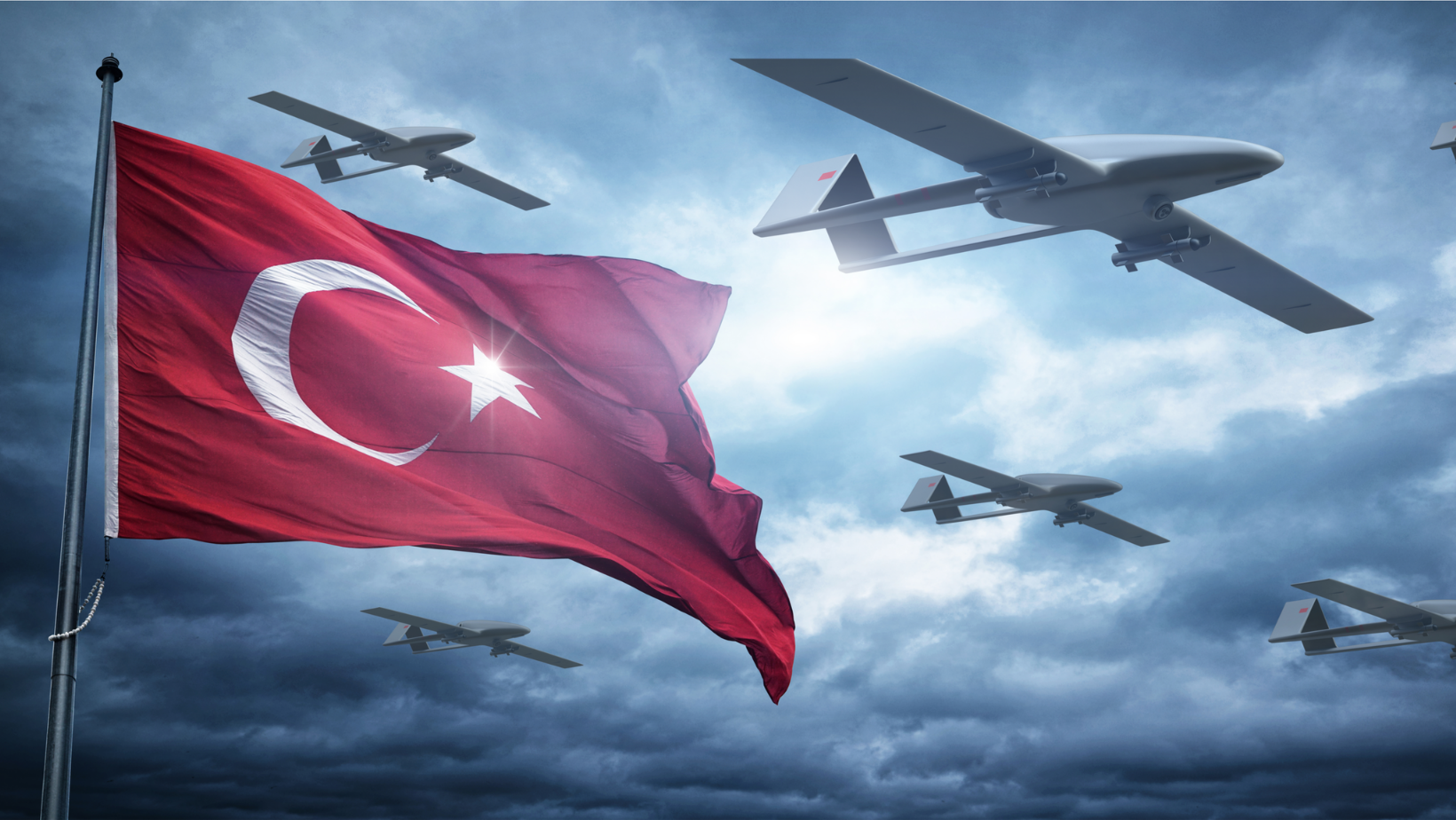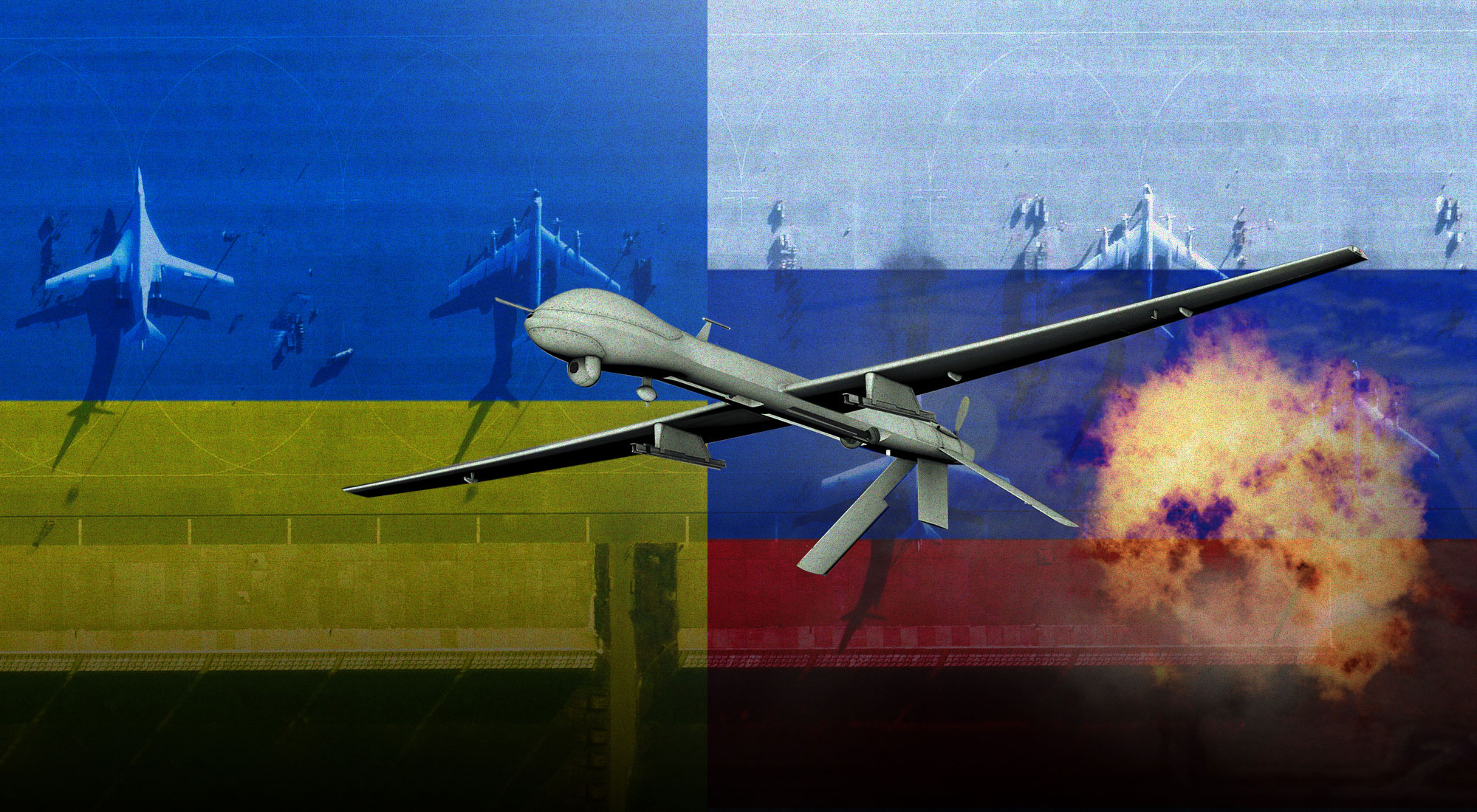Introduction
Ankara’s growing operational use of armed drones in Turkey’s near abroad has attracted much attention from foreign policy analysts, media pundits and statesmen in regional capitals and beyond. Turkey’s ascendancy as one of the world’s most prolific armed drone users has been sudden. Using domestically manufactured systems to project prestige and power in its near-abroad and further, Ankara has seemingly benefited tremendously from this maturing technology. Turkish leaders have clearly absorbed military and political lessons from their recent forays into armed drone usage, lessons they will undoubtedly incorporate in future operations. Indeed, Turkey has learned multiple, cumulative and individual lessons about armed drone usage from engaging – either directly or indirectly – in simultaneous or sequential military actions – from inside Turkey to northern Iraq, Libya, Syria, and the Caucasus. Alongside and also tied to this military experience has been a broader evolution in how Ankara uses drones as a foreign policy asset.
Any explanation of Turkey’s military actions in its near-abroad, its efforts at creating an indigenous defense industrial capacity, and, and linked to these, its new-found status as a drone power, needs to be contextualized. Turkey is a middle power experiencing – albeit in fits and starts – significant economic and military growth. Geopolitically, Turkey’s relationship with Europe and the U.S. has deteriorated in the past decade or so, with the result that options for importing sophisticated and fast-developing weaponry have been increasingly curtailed. In response, Turkey has accelerated efforts to achieve greater self-reliance in armaments production. By 2011, 52 percent of the Turkish military’s defense equipment was being assembled domestically. Three years later, that figure jumped to 60 percent.[1] Yet, autarky in arms production is an economically inefficient way to acquire weapons and no longer practical for most states. Indeed, the processes associated with defense-industrial globalization, combined with the ever-rising costs of producing leading-edge weapons systems, present huge disincentives for autarky in armaments.[2] Reflecting this, most Turkish weapons have remained largely dependent on the importation of foreign technology. Turkey did, however, identify one niche capability for indigenous production – armed drones.
Birth of indigenous drones
Up to the early 2000s, Turkey had looked to Israel for drones. Turkey was Israel’s primary customer in the purchase of the Heron UAV. The homegrown drone industry emerged after Turkey stopped purchasing Israeli drones for political reasons and was barred from acquiring U.S.-made Predator drones. The subsequent push into indigenous drone production has resulted in several systems of internationally competitive quality, including the Bayraktar TB2.
The story of the Bayraktar TB2 – a system that has become one of Turkey’s biggest weapons success stories – has a personal twist. Selçuk Bayraktar, an MIT-educated engineer, transformed his family’s company, Baykar Defense, into a major supplier of UAVs to the Turkish Armed Forces (TAF) and other Turkish security agencies. This move turned Bayraktar, who is also Erdoğan’s son-in-law, into a national hero.
Carrying laser-guided munitions since 2015, the Bayraktar TB2 is a capable tactical drone with a flight endurance of 24 hours. Its development commenced in 2009 with financing from the Undersecretariat for Defense Industries (Savunma Sanayii Başkanlığı, SSM) and the industry department of the Ministry of National Defense (Milli Savunma Bakanlığı), the Bayraktar TB2 IS has become the most prominent armed drone produced in Turkey.
Turkey has also seen the development of other UAVs. At 26 feet in length and with a roughly 400-pound payload, the Anka-S is Turkey’s strategic drone.[3] This propeller-driven drone can fly for more than 24 hours straight and fire small, precision-guided missiles. Produced by TAI (Turkish Aerospace Industries), the drone’s satellite-control feature, which equips the drone with beyond the line-of-sight functions, makes the Anka-S a more capable platform than the Bayraktar TB2. It carries a synthetic-aperture radar (SAR), an inverse-SAR and a ground-moving-target-indicator radar to detect, identify and track ground targets.[4]
In addition to the TB-2, Baykar Defense has manufactured and now delivered the first batch of the Akıncı, a High-Altitude Long-Endurance (HALE) drone, to the Turkish Air Force (Türk Hava Kuvvetleri). This drone is equipped with satellite communication systems, air-to-air radar, collision avoidance radar and synthetic aperture radar..[5]
In total, the Turkish military now has an estimated 130 drones of various designs. Such rapid gains in indigenous drone capabilities did not happen spontaneously: they were rather the result of a concerted, top-down effort by Turkey’s political leaders. Speaking about drones and local defense production in 2019, President Erdoğan commended his country’s efforts, stating that: “we started from 20 percent domestically produced, and now we are producing 70 percent.”[6] The operational benefits accrued from possessing domestically made unmanned systems have been clearly demonstrated in recent conflicts. Indeed, Turkey’s top procurement body, the SSM, released a 2018 – 2022 Sectoral Strategy Document that refers to autonomous weapons systems as the “third revolution in battlegrounds” after gunpowder and nuclear weapons. It also states that Turkey needs to further boost the national unmanned aerial systems’ capabilities.[7] Analysis of Turkey’s experience in using armed drones in recent conflicts shows why and how this technology has gained such a central place in Ankara’s foreign and military policies.
Turkish armed drone usage
Turkey’s sense of its own resurgent power has driven its recent increasing interest in its near abroad and beyond to include the wider Middle East and Africa. Turkey’s approach to its near abroad has been multi-faceted and ongoing in places such as Syria and Libya long before Turkey began building drones. In this context, drones represent just one more vector of Turkish power projection. Yet it is Turkey’s new-found assertiveness – with drones at the forefront – that has had an impact on a wider region from the Caucasus to the Arabian Peninsula and North Africa.
Early drone forays
Turkish security forces have been using Turkish-built armed drones for internal security since the first systems were delivered in 2015. They have been a major boon for government forces in a decades-old counterinsurgency against the Kurdistan Workers’ Party (PKK).[8] Since at least 2016, Turkish forces have used armed drones to strike Kurdish militants inside Turkey and across the border in Syria and the autonomous Kurdish region of northern Iraq.[9]
Contemporaneously, Turkey also used the Bayraktar TB-2 against ISIS in Syria during its Operation Euphrates Shield and along Turkey’s border with Iraq and Iran. Operation Olive Branch – a 2018 cross-border military operation by Turkey into Syria – also saw the extensive use of the Bayraktar TB-2. Of the total 3,391YPG/PKK militants claimed to have been killed by the Turkish military and local allies, 449 were reported to have been directly killed by tactical armed drones. The Bayraktar TB-2s also performed target acquisition for other platforms leading to a further reported 680 fatalities.[10]
Digesting the lessons from Operation Euphrates Shield and Operation Olive Branch, Turkish political-military decision-makers focused on the vulnerability of military personnel in battlespaces. Advances in anti-tank guided missiles (ATGM) and improvised explosive devices (IEDs) posed menacing threats to armor survivability, while man-portable air defense systems (MANPADS) placed aerial platforms, especially rotary-wing and low-flying attack aircraft, at constant risk. Within these operations, drones proved not only to be a force multiplier, but also a means of reducing Turkish casualties. This combination of benefits would prove to be even more attractive to Turkey’s leaders as they contemplated future military intervention in Syria and elsewhere.
Syria: Operation Spring Shield
Early 2020 proved to be a significant moment for Turkey’s armed drones. On 27 February, an airstrike against a Turkish military convoy and observation post in southern Idlib killed approximately three-dozen Turkish soldiers.[11] Three days later, Turkey launched a combined ground, artillery and air operation called “Spring Shield” against the Syrian army. The Turkish air campaign was brief, beginning on 1 March and ending just five days later, when Ankara and Moscow hammered out a regional cease-fire.
Turkish drones featured prominently in the Spring Shield air campaign. Importantly, they, along with manned aircraft, bested the Syrian regime’s air-defenses and destroyed the regime’s Russian-supplied Pantsir air-defense vehicles. In total, eight Pantsir and Russian-made Tor air defense systems were reportedly put out of action by Turkish armed drones within a week.[12] Turkish officials boasted to news outlets that these devasting attacks had been achieved by a deadly drone “swarm.”[13] Spring Shield in fact saw the combat debut for the Anka-S, which allowed Turkey to take advantage of the drone’s large payload capacity. However, the Turkish military’s emphasis on the effectiveness of its drones something of an exaggeration: as in reality, the successful suppression of Syrian air-defense systems was due to the Turkish forces’ effective integration of rocket systems and artillery batteries with the drones..[14]
Turkey’s Libya intervention
As part of its operations in Libya, Turkey deployed 10 TB2 drones in June 2019 to help the GNA hold onto Tripoli. Turkish military personnel deployed the drones using relay masts built by the TAF in order to extend the range of the Bayraktar TB2s. The TB2 initially performed poorly and, according to some reports, all the drones were destroyed by LNA airstrikes using Wing Loong drones by the end of October 2019.[15] In response to this, the GNA pleaded with Turkey for more drones. The problem with this request was that Baykar Defence could not produce Bayraktar TB2s quickly enough. By the end of 2019, the LNA appeared to have the upper hand.
A critical turning came in Spring 2020, when Turkish drones, in coordination with Turkish warships, attacked the strategic al-Watiya air base, about 80 miles south of Tripoli, allowing government forces to capture the base and end the LNA’s Tripoli offensive. In addition, what appear to be unspecified modifications quickly made to the Bayraktar TB2 during late 2019 meant that by Spring 2020, Turkish drone strikes had helped the U.N.-backed government to retake nearly all of western Libya from LNA forces.[16]
Arming Azerbaijan
The six-week conflict in Fall 2020 between Azerbaijan and Armenia over the disputed territory of Nagorno-Karabakh brought a new prominence to Turkey’s drone program. Turkish drones were critical to Azerbaijan in its conflict with Armenian forces.[17] With Turkey’s support, Azerbaijan retook swaths of territory it had lost during the initial conflict over the region from 1988-1994.
During the fighting, Turkey’s Bayraktar TB2 drones and Israeli-made kamikaze drones helped the Azerbaijani forces to overwhelm Armenia’s defenses. The TB2 drones destroyed a number of Armenian positions by targeting armored vehicles and anti-aircraft systems.[18] The close-air support provided by Turkish drones proved critical for Azerbaijan’s mechanized and armored military to perform lightning strikes and occupy ground.
Baku also had the upper hand on account of a digital terrain model (DTM) of Nagorno-Karabakh that it had obtained from an Israeli contractor some years previously.[19] This provided the Azerbaijani government and military with a precise representation of the mountainous region based on a mix of radar, human sensor and imagery intelligence. Using the model, the Azerbaijan’s armed forces were able to use its TB2s and Israeli drones to perform precision strikes.
Conclusions
Although Turkey’s drones are but one aspect of Turkish power projection, they have played an outsized role in recent Turkish military interventions and operations. There are reasons to qualify Turkish successes in the drone sector. For one thing, Turkey is reliant on the importation of sensors and other sensitive equipment from the U.S., the U.K, Canada and others. As these states have all signaled that they will no longer sell such equipment to Turkey, Turkey’s drone development could potentially be stalled. Also, other states are studying Turkish drone deployment in Libya, Syria, and Nagorno-Karabakh. It is safe to say that a variety of systems as well as better drones may be deployed the next time Turkey takes to the battlefield with its drones.
Nonetheless, the perceived success of Turkish drones in Syria and elsewhere has led some to claim that the systems as equal to the best Chinese drones and perhaps capable of closing the gap with Western and Israeli UAVs, even to the extent of being comparable to the U.S. Reaper drone.[20] Although many states with deep pockets and strong military links to the U.S. and the West may double-down on purchasing better-made drones from these sources, Turkish systems have nevertheless already carved out a strong place in the growing market for military drone technologies. The Bayraktar TB2 was ordered by Ukraine in January 2019, with the first delivery taking place in June of the same year. Other key allies have also purchased Turkish drones. Qatar reportedly has acquired six Bayraktar systems, while Pakistan is reportedly interested in purchasing Turkish mini drones. In addition, Turkey and Poland have signed a deal for the sale of combat drones, making Poland the first NATO and European Union member country to purchase Turkey’s Bayraktar TB2.[21] In North Africa, Tunisia has awarded TAI a $240 million contract for six Anka-S drones.[22]
Overall, the Turkish drone program represents a significant technological and engineering achievement. Aside from Turkey, there is only a handful of countries capable of producing sophisticated, armed drones. What makes Turkey’s accomplishments more remarkable is the speed with which this was achieved. TAI only started making Anka-Ss in 2013, while Baykar Defense began its Bayraktar TB2 production in 2014. Given its overwhelmingly positive experience with armed drones, there is good reason to think that Turkey will continue to play a prominent role in the future use and production of these advanced weapon systems.
References:
[1] Hüseyin Bağcı and Çağlar Kurç, “Turkey’s Strategic Choice: Buy or Make Weapons?” Defence Studies 17, no. 1 (2017), p. 44.
[2] See for example: Ash Rossiter, and Brendon J. Cannon, “Making arms in India? Examining New Delhi’s renewed drive for defence-industrial indigenization,” Defence Studies 19, no. 4 (2019), p. 353.
[3] Jane’s 360, http://www.janes.com/article/75160/turkey-to-start-testing-satcom-control-of-anka-s-uav.
[4] David Axe, “Turkey is The Middle East’s Newest Drone Super Power?” National Interest, 9 May 2020. https://nationalinterest.org/blog/buzz/turkey-middle-easts-newest-drone-super-power-142242.
[5] Baykar Makina, “Baykar Unmanned Aerial Vehicle Systems,” https://baykardefence.com/uav-14.html.
[6] Quoted in Kareem Fahim, “Turkey’s Military Campaign beyond its Borders is Powered by Homemade Armed Drones,” Washington Post, 30 November 2020, https://www.washingtonpost.com/world/middle_east/turkey-drones-libya-nagorno-karabakh/2020/11/29/d8c98b96-29de-11eb-9c21-3cc501d0981f_story.html.
[7] The Undersecretariat for Defense Industries, 2018 – 2022 Savunma Sanayii Sektörel Strateji Dokümanı (2018), pp. 50-53.
[8] Umar Farooq, “The Second Drone Age,” The Intercept, 14 May 2019, https://theintercept.com/2019/05/14/turke y-second-drone-age/.
[9] “Turkey, Iran Deploy ‘Game-changing” drones in North Iraq,” France24, 1 October 2020, https://www.france24.com/en/20201001-turkey-iran-deploy-game-changing-drones-in-north-iraq; Francesco F. Milan and Aniseh Bassiri Tabrizi, “Armed, Unmanned, and in High Demand: The Drivers behind Combat Drones Proliferation in the Middle East,” Small Wars & Insurgencies 31 No. 4 (2020): 730–50..
[10] Necdet Özçelik, “Askeri Harekatların Kuvvet Çarpanı: İnsansız Hava Araçları,” Anadolu Ajansı, April 2018, https://aa.com.tr/tr/analiz-haber/askeri-harek%C3%A2tlarin-kuvvet-carpani-insansiz-hava-araclari/1122660.
[11] C. Gall, “Airstrike Hits Turkish Forces in Syria, Raising Fears of Escalation,” New York Times, 27 February 2020, https://www.nytimes.com/2020/02/27/world/middleeast/russia-turkey-syria-war-strikes.html/.
[12] Yeni Safak, “Koral, SİHA ve F-16lar: Rus yapımı hava savunma sistemlerinin kabusu oldular,” 04 March 2020. https://www.yenisafak.com/dunya/koral-siha-ve-f-16lar-rus-yapimi-hava-savunma-sistemlerinin-kabusu-oldular-3528104
[13] Selcan Hacaoglu, “Turkey’s Drone Swarm Poses Syria Air Challenge to Putin,” Bloomberg, 1 March 2020, https://www.bloomberg.com/news/articles/2020-03-01/turkey-s-killer-drone-swarm-poses-syria-air-challenge-to-putin?sref=pc0jemCL.
[14] Karnozov, “Fighter-bombers and Anka UAVs Downed as Turkey and Syria Exchange Blows,” Aviation International News, 2 March 2020, https://www.ainonline.com/aviation-news/defense/2020-03-02/fighter-bombers-and-anka-uavs-downed-turkey-and-syria-exchange-blows/
[15] Africa Intelligence, “The Chinese army loses its first drone in Libya.” 5 September 2019.
[16] Sudarsan Raghavan, “As Military Power Shifts in Libya, Turkey and Russia Control Country’s fate,” Washington Post, 23 March 2020, https://www.washingtonpost.com/world/middle_east/as-military-power-shifts-in-libya-turkey-and-russia-control-its-fate/2020/05/23/bb6a83c8-9c50-11ea-b60c-3be060a4f8e1_story.html.
[17] Dixon, Robyn (2020). ‘Azerbaijan’s Drones Owned the Battlefield in Nagorno-Karabakh — and Showed Future of Warfare’. Washington Post, 11 October 2020. https://www.washingtonpost.com/world/europe/nagorno-karabkah-drones-azerbaijanaremenia/2020/11/11/441bcbd2-193d-11eb-8bda-814ca56e138b_story.html; Fahim, Kareem, ‘Turkey’s Military Campaign beyond Its Borders Is Powered by Homemade Armed Drones’. Washington Post, 29 November 2020. https://www.washingtonpost.com/world/middle_east/turkey-drones-libya-nagornokarabakh/2020/11/29/d8c98b96-29de-11eb-9c21-3cc501d0981f_story.html; Sabbagh, Dan. 2020. ‘UK Wants New Drones in Wake of Azerbaijan Military Success’. The Guardian. 29 December 2020. http://www.theguardian.com/world/2020/dec/29/uk-defence-secretaryhails-azerbaijans-use-of-drones-in-conflict.
[18] Can Kasapoğlu, “Türk Harp Yaklaşımında ‘Dronizasyon’ Dönemi: Azerbaycan, Türkiye’nin Orta Doğu’daki SİHA Konseptlerini Kafkasya’ya Taşıdı,” EDAM, 28 September 2020. https://edam.org.tr/turk-harp-yaklasiminda-dronizasyon-donemi-azerbaycan-turkiyenin-orta-dogudaki-siha-konseptlerini-kafkasyaya-tasidi/#_ftn4
[19] Intelligence Online, “Baku wins intelligence war thanks to Israeli contracts, 08 December 2020.
[20] David Axe, “Turkey is The Middle East’s Newest Drone Super Power?” The National Interest, 9 May 2020. https://nationalinterest.org/blog/buzz/turkey-middle-easts-newest-drone-super-power-142242; see also, Intelligence Online, “Erdoğan family’s drones help Turkey’s diplomacy in Africa and the Gulf.” 10 June 2019.
[21] “Poland to become First NATO Country to Buy Turkish Drones,” Reuters, 22 May 2021, https://www.reute rs.com/world/europe/poland-become-first-nato-country-buy-turkish-drones-2021-05-22/.
[22] Burak Ege Bekdil, “Turkey’s TAI sells six Anka-S drones to Tunisia.” Defense News, 16 March 2020. https://www.defensenews.com/unmanned/2020/03/16/turkeys-tai-sells-six-anka-s-drones-to-tunisia/.








